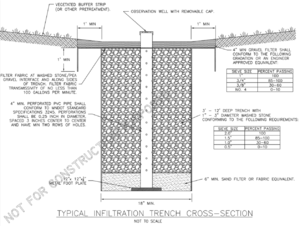
Difference between revisions of "Infiltration design guideline - Observation well"
m |
m |
||
| (4 intermediate revisions by the same user not shown) | |||
| Line 1: | Line 1: | ||
[[File:Typical infiltration trench cross-section 2.png|300px|thumb|alt=schematic of an observation well|<font size=3>Schematic of a typical infiltration trench cross-section, including an observation well.</font size>]] | [[File:Typical infiltration trench cross-section 2.png|300px|thumb|alt=schematic of an observation well|<font size=3>Schematic of a typical infiltration trench cross-section, including an observation well.</font size>]] | ||
| − | Infiltration practices should include an observation well, consisting of an anchored 4- to 6-inch diameter perforated PVC pipe fitted with a lockable cap installed flush with the ground surface. See [ | + | Infiltration practices should include an <span title="A well used to observe changes in groundwater levels or groundwater quality over a period of time."> '''observation well'''</span>, consisting of an anchored 4- to 6-inch diameter perforated PVC pipe fitted with a lockable cap installed flush with or above the ground surface. See [https://www.dot.state.mn.us/manuals/ MNDOT Manual Section 3248] for design guidance on PVC pipes. It is recommended to install one well per 50 feet of length in the infiltration practice. For <span title="Permeable pavements allow stormwater runoff to filter through surface voids into an underlying stone reservoir for temporary storage and/or infiltration. The most commonly used permeable pavement surfaces are pervious concrete, porous asphalt, and permeable interlocking concrete pavers (PICP)."> '''[https://stormwater.pca.state.mn.us/index.php?title=Permeable_pavement permeable pavement]'''</span> systems with greater than 10,000 square feet of <span title="The total drainage area, including pervious and impervious surfaces, contributing to a BMP"> '''[https://stormwater.pca.state.mn.us/index.php?title=Contributing_drainage_area_to_stormwater_BMPs contributing drainage area]'''</span>, the observation well should be placed at the downstream end of the practice. |
| − | The purpose of the observation well is to monitor water drainage in the infiltration practice. Check observation wells within the specified drawdown time (24 or 48 hours) after a storm event. Standing water in the well is an indication of clogging of the infiltration system. Observation wells should not be used for water quality monitoring since monitoring wells extend into underlying groundwater. | + | The purpose of the observation well is to monitor water drainage in the infiltration practice. Check observation wells within the specified <span title="The length of time, usually expressed in hours, for ponded water in a stormwater practice to drain. For stormwater practices where water is stored in media, there is no clear definition of drawdown, but an acceptable assumption is the time for water to drain to field capacity"> '''drawdown time'''</span> (24 or 48 hours) after a storm event. Standing water in the well is an indication of clogging of the infiltration system. Observation wells should not be used for water quality monitoring since monitoring wells extend into underlying groundwater. |
A detail of a typical infiltration cross-section, which includes an observation well, can be found [http://stormwater.pca.state.mn.us/index.php/File:INFILTRATION_TRENCH_INFILTRATION_TRENCH_SECTION_%281%29.pdf at this link]. This detail includes construction sequencing and other design information. | A detail of a typical infiltration cross-section, which includes an observation well, can be found [http://stormwater.pca.state.mn.us/index.php/File:INFILTRATION_TRENCH_INFILTRATION_TRENCH_SECTION_%281%29.pdf at this link]. This detail includes construction sequencing and other design information. | ||
| + | |||
| + | [[Category:Level 3 - Best management practices/Structural practices/Infiltration (trench/basin)]] | ||
| + | [[Category:Level 3 - Best management practices/Specifications and details/Design criteria]] | ||
Latest revision as of 19:16, 27 December 2022
Infiltration practices should include an observation well, consisting of an anchored 4- to 6-inch diameter perforated PVC pipe fitted with a lockable cap installed flush with or above the ground surface. See MNDOT Manual Section 3248 for design guidance on PVC pipes. It is recommended to install one well per 50 feet of length in the infiltration practice. For permeable pavement systems with greater than 10,000 square feet of contributing drainage area, the observation well should be placed at the downstream end of the practice.
The purpose of the observation well is to monitor water drainage in the infiltration practice. Check observation wells within the specified drawdown time (24 or 48 hours) after a storm event. Standing water in the well is an indication of clogging of the infiltration system. Observation wells should not be used for water quality monitoring since monitoring wells extend into underlying groundwater.
A detail of a typical infiltration cross-section, which includes an observation well, can be found at this link. This detail includes construction sequencing and other design information.
This page was last edited on 27 December 2022, at 19:16.
